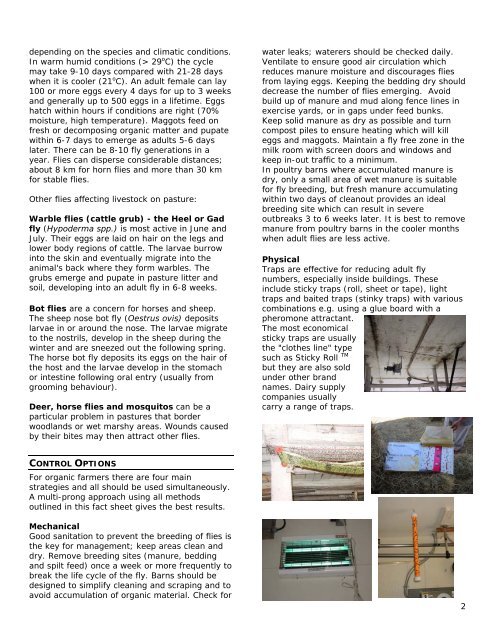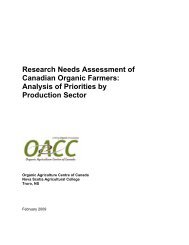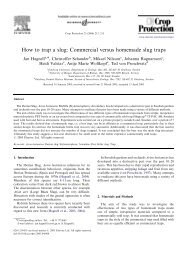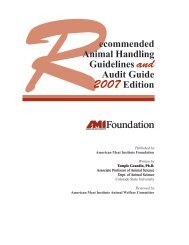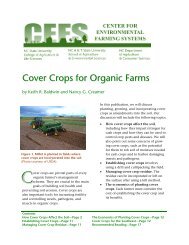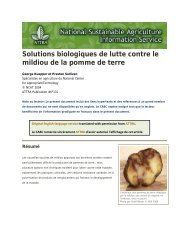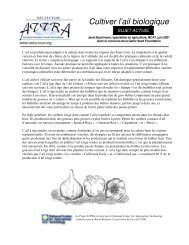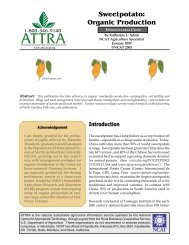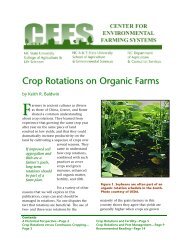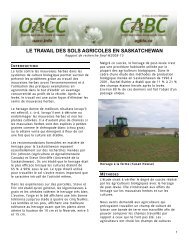management of pest flies on organic farms - Le centre d'agriculture ...
management of pest flies on organic farms - Le centre d'agriculture ...
management of pest flies on organic farms - Le centre d'agriculture ...
You also want an ePaper? Increase the reach of your titles
YUMPU automatically turns print PDFs into web optimized ePapers that Google loves.
depending <strong>on</strong> the species and climatic c<strong>on</strong>diti<strong>on</strong>s.In warm humid c<strong>on</strong>diti<strong>on</strong>s (> 29 o C) the cyclemay take 9-10 days compared with 21-28 dayswhen it is cooler (21 o C). An adult female can lay100 or more eggs every 4 days for up to 3 weeksand generally up to 500 eggs in a lifetime. Eggshatch within hours if c<strong>on</strong>diti<strong>on</strong>s are right (70%moisture, high temperature). Maggots feed <strong>on</strong>fresh or decomposing <strong>organic</strong> matter and pupatewithin 6-7 days to emerge as adults 5-6 dayslater. There can be 8-10 fly generati<strong>on</strong>s in ayear. Flies can disperse c<strong>on</strong>siderable distances;about 8 km for horn <str<strong>on</strong>g>flies</str<strong>on</strong>g> and more than 30 kmfor stable <str<strong>on</strong>g>flies</str<strong>on</strong>g>.Other <str<strong>on</strong>g>flies</str<strong>on</strong>g> affecting livestock <strong>on</strong> pasture:Warble <str<strong>on</strong>g>flies</str<strong>on</strong>g> (cattle grub) - the Heel or Gadfly (Hypoderma spp.) is most active in June andJuly. Their eggs are laid <strong>on</strong> hair <strong>on</strong> the legs andlower body regi<strong>on</strong>s <str<strong>on</strong>g>of</str<strong>on</strong>g> cattle. The larvae burrowinto the skin and eventually migrate into theanimal's back where they form warbles. Thegrubs emerge and pupate in pasture litter andsoil, developing into an adult fly in 6-8 weeks.Bot <str<strong>on</strong>g>flies</str<strong>on</strong>g> are a c<strong>on</strong>cern for horses and sheep.The sheep nose bot fly (Oestrus ovis) depositslarvae in or around the nose. The larvae migrateto the nostrils, develop in the sheep during thewinter and are sneezed out the following spring.The horse bot fly deposits its eggs <strong>on</strong> the hair <str<strong>on</strong>g>of</str<strong>on</strong>g>the host and the larvae develop in the stomachor intestine following oral entry (usually fromgrooming behaviour).Deer, horse <str<strong>on</strong>g>flies</str<strong>on</strong>g> and mosquitos can be aparticular problem in pastures that borderwoodlands or wet marshy areas. Wounds causedby their bites may then attract other <str<strong>on</strong>g>flies</str<strong>on</strong>g>.water leaks; waterers should be checked daily.Ventilate to ensure good air circulati<strong>on</strong> whichreduces manure moisture and discourages <str<strong>on</strong>g>flies</str<strong>on</strong>g>from laying eggs. Keeping the bedding dry shoulddecrease the number <str<strong>on</strong>g>of</str<strong>on</strong>g> <str<strong>on</strong>g>flies</str<strong>on</strong>g> emerging. Avoidbuild up <str<strong>on</strong>g>of</str<strong>on</strong>g> manure and mud al<strong>on</strong>g fence lines inexercise yards, or in gaps under feed bunks.Keep solid manure as dry as possible and turncompost piles to ensure heating which will killeggs and maggots. Maintain a fly free z<strong>on</strong>e in themilk room with screen doors and windows andkeep in-out traffic to a minimum.In poultry barns where accumulated manure isdry, <strong>on</strong>ly a small area <str<strong>on</strong>g>of</str<strong>on</strong>g> wet manure is suitablefor fly breeding, but fresh manure accumulatingwithin two days <str<strong>on</strong>g>of</str<strong>on</strong>g> cleanout provides an idealbreeding site which can result in severeoutbreaks 3 to 6 weeks later. It is best to removemanure from poultry barns in the cooler m<strong>on</strong>thswhen adult <str<strong>on</strong>g>flies</str<strong>on</strong>g> are less active.PhysicalTraps are effective for reducing adult flynumbers, especially inside buildings. Theseinclude sticky traps (roll, sheet or tape), lighttraps and baited traps (stinky traps) with variouscombinati<strong>on</strong>s e.g. using a glue board with apherom<strong>on</strong>e attractant.The most ec<strong>on</strong>omicalsticky traps are usuallythe "clothes line" typesuch as Sticky Roll TMbut they are also soldunder other brandnames. Dairy supplycompanies usuallycarry a range <str<strong>on</strong>g>of</str<strong>on</strong>g> traps.CONTROL OPTIONSFor <strong>organic</strong> farmers there are four mainstrategies and all should be used simultaneously.A multi-pr<strong>on</strong>g approach using all methodsoutlined in this fact sheet gives the best results.MechanicalGood sanitati<strong>on</strong> to prevent the breeding <str<strong>on</strong>g>of</str<strong>on</strong>g> <str<strong>on</strong>g>flies</str<strong>on</strong>g> isthe key for <str<strong>on</strong>g>management</str<strong>on</strong>g>; keep areas clean anddry. Remove breeding sites (manure, beddingand spilt feed) <strong>on</strong>ce a week or more frequently tobreak the life cycle <str<strong>on</strong>g>of</str<strong>on</strong>g> the fly. Barns should bedesigned to simplify cleaning and scraping and toavoid accumulati<strong>on</strong> <str<strong>on</strong>g>of</str<strong>on</strong>g> <strong>organic</strong> material. Check for2


